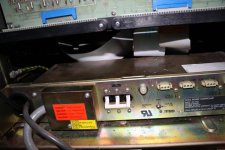I now have a light bulb (reads 0.7 ohms), and am ready to test the PSU. I am able to use the front panel switch to energize it. I did a check between the 5+ and ground rails, and they read continuous. Is that a problem or is it part of the design because I know that some transformers can read continuous from live to ground.
After checking it some more, the problem seems to go away when the multimeter is connected for a few seconds, but there is resistance in the megaohm range. I am guessing that the complexity of this circuit could lead many possible paths. It almost seems like something is charging up which breaks the connection. When I connect the lamp, it reads continuous. I then disconnect it and the meter reads continuity for a few seconds before stopping. Just out of curiosity I measured the continuity between the flex print cables leading to the backpane (not attached to the PSU), and they read continuous.

